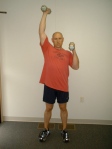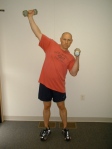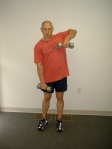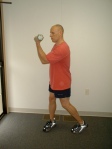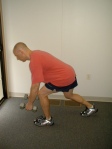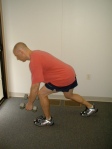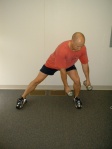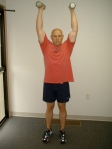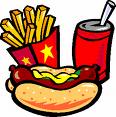Never Workout Without Music! 
Did you ever pay attention to the soundtrack of your favorite TV show or movie? Did you every wonder why certain songs were playing at certain times? Music evokes emotion, and emotion can carry you through even the toughest of workouts. I’ve had workouts totally come apart when the battery died on my iPod Nano!
Several studies have been conducted to show the effect of music on workouts. One study showed that upbeat, hard-driving music can increase your strength and intensity, while another study revealed that music has been shown to increase pain tolerance during a workout.
Putting on a pair of headphones also helps you to block out all of the distractions that loom at the gym (as previously noted). Sometimes, just hearing the opening beat of some of the tunes on my iPod gets me revved up – especially since I workout first thing in the morning (more on this in future issues of the newsletter).
Some of my favorite tunes on my workout list include a variety of genres:
“Eye of the Tiger” – Survivor
“Welcome to the Jungle” – Guns ‘n Roses
“Beautiful Day” – U2
“Wake Up Call” – Maroon 5
“Enter Sandman” – Metallica
“Higher” – Creed
Make your own workout mix and get moving!
Never Workout Without a Heart Rate Monitor!
The best way to keep yourself honest in the gym is to wear a heart rate monitor. A heart rate monitor will let you know how hard you are working, and when you need to crank up the intensity of your workout. Whether weight training or interval training, it is the best indicator of how hard you are working and help you to figure out your optimal rest intervals.
For example, during interval training, you need to create an oxygen debt – that is, your body is asking your lungs for more oxygen than it can provide. How do you know this is happening? After you stop your hard effort, your heart rate should actually increase and you begin to pant in an effort to take in more oxygen – and that is your debt situation. Having the HRM makes it much easier to determine when you’ve reached this point.
I’ll go into the optimal ranges for your heart rate activity during exercise, calculating your maximum heart rate and other relevant information. For now, get a heart rate monitor, read the manual and take it for a test drive. You don’t need one with all of the bells and whistles (unless you’re into gadgets like me) – my favorite brand is Polar, and you can get great prices by searching the Web.
Stop Socializing at the Gym!
Every gym has one – I call him “the Mayor”. He’s the one who knows everyone and feels the need to come over and talk about just about anything. He’ll do his very uninspired set on one of the weight machines, often grunting loudly or distorting his face to get further attention, and when he finishes says “Whew!” loudly to no one in particular. The poor soul who acknowledges him will then be subjected to a 10-minute discussion on the economy, the presidential race, the stock market, or whatever strikes his fancy. He may even horse around with the personal trainers, who are now not watching their clients as they perform their sets.
You should avoid the Mayor at all costs – he will derail your fat loss efforts in an instant! In fact, you should avoid all interaction during your workout, with the exception of asking someone if they are using a particular weight or rack. If you’re following my advice above and working out to music, this is really easy to accomplish – just turn up your tunes and tune out the others.
Folks at my gym may think I’m anti-social because I don’t acknowledge anyone – heck I don’t even look at people – while I’m in the middle of my workout. Why? Because I only have a limited time to accomplish my goals for that day, and stopping even for a moment to chat takes away from the time I have. And if I don’t reach my goal for that day, I consider it a failure (more on that in future newsletters). To combat people’s perceptions, if you care about things like that, a simple smile or wave hello as you enter or leave the gym is enough to reassure them that you are not a recluse. But once you strap on your music, it’s “Go Time!”
Never Workout Without Consuming Protein Afterwards (and Sometimes Before)
I train first thing in the morning, so sometimes I drink a protein shake prior to heading to the gym, sometimes I don’t. There is a lot of debate over working out in a fasted state that I won’t get into here. Suffice it to say that consuming protein before your workout has been shown in research to increase muscle mass and decrease body fat, so it is a good idea to have a protein shake before a workout, especially if you’ll be working out later in the day.
You should always consume protein after a workout, preferably a protein shake made from whey protein isolate. I will go into much greater detail in subsequent newsletters about reliable brands, tasty recipes, etc. How much protein? Take your current body weight and divide by 5.5 – that is how many grams of protein should be in your post-workout shake. What about carbs? The conventional wisdom says that the number of grams of carbs in the post-workout shake should equal the number of grams of protein. BUT…what I have found through my research and practice is that post-workout shakes are more effective for fat loss if they are kept low in carbs. One of the aspects of protein consumption that will be covered later is exactly how many grams should be consumed in a day, and questions about safety concerns from ingesting large amounts of protein.
Stop Stretching Before Your Workout
Do you know how many people walk into the gym from the street and immediately start to stretch? Do you know how counter-productive this is?
First, there are two kinds of stretches – static and dynamic. An example of static is when you throw your leg up on a parallel bar or rack and bend at the waist until you feel a slight pull, then hold for a period of time. Static stretching before workouts is a very bad idea. Static stretching forces the muscle to relax, this making it weaker. When a muscle is weaker than its counterpart (for example if your hamstrings on the backs of your leg are weaker than your quadriceps in the front of your leg) it causes an imbalance that could lead to strains, tears and pulls.
Dynamic stretching is the way to go to get loose before your workout. Save your static stretching for any time other than before your workout.
Part 2 of the great article by Matt Lisk
Get Strong! Stay Strong! ( and for Gods sake take this advice!)
Chris
